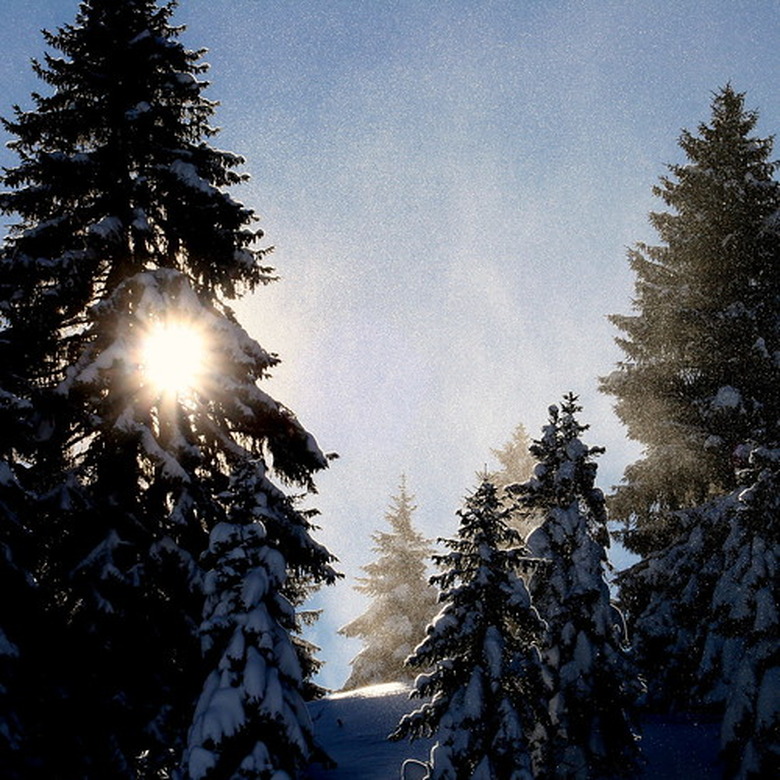Photosynthesis In Pine Trees
Pine trees are evergreens, which means they keep their needles year-round. This gives evergreens an advantage over deciduous plants that lose their leaves every fall. There are 120 species of evergreen conifers in the pine genus (Pinus). One particular species of pine, the bristlecone pine, lives in the Rocky Mountains with one individual thought to be more than 5,000 years old!
Leaf Structure
Leaf Structure
So what gives these pines an advantage over other trees and plants? Pine trees have modified leaves called "needles." A characteristic feature of pine trees is the way needles are arranged in bundles, compared to spruce trees where needles are attached directly to the branch. Evergreen needles have a thick outer coating, called a cuticle, which allows them to retain more water.
There are pores in this outer coating called "stomata," which can open and close if a plant needs to conserve or release water. This means that needles can help pine trees live in drier climates where water conservation is important.
Chloroplasts
Chloroplasts
Plant cells have many different organelles that carry out functions essential to the plant's survival. One type of organelle is a chloroplast, which is only roughly 0.001 mm thick! Two pigments, chlorophyll a and chlorophyll b, give chloroplasts a green color, which is also why plant leaves are green. Chloroplasts are energy-producing powerhouses that create and store foodstuffs through a process known as photosynthesis.
Photosynthesis
Photosynthesis
Green plants are able to use photosynthesis to take carbon dioxide, water and energy from the sun and convert it into chemical energy. It converts these compounds into oxygen, which is released into the atmosphere, and organics, like sugar.
Most energy that is cycling through our ecosystems has started with the sun. Plants photosynthesize to get sugar and oxygen from sunlight, then animals eat and get energy from plants, and animals eat other animals.
What Limits Photosynthesis in Winter Evergreens?
What Limits Photosynthesis in Winter Evergreens?
There are many factors that can influence the rate of photosynthesis in winter evergreens. Less light and colder temperatures in the winter are limiting factors for photosynthesis. The more light and warmer temperatures a plant has, the more effective it will be at creating sugars and other products using the sun's energy. The plants health, age and flowering state can also change the rate of this process.
Carbon dioxide is needed as a carbon source to create sugars and other organic compounds. The more carbon dioxide that is available, the faster the rate of photosynthesis reactions. As the stomata in a pine's needles open to take in carbon dioxide, water is inevitably lost through these pores as vapor.
Minerals can also be a limiting factor of photosynthesis. Nitrogen, phosphate, sulfate, iron, calcium and magnesium are necessary for plants to create proteins, DNA and chlorophyll. Plants also require elements like manganese, copper and chloride to complete photosynthesis successfully.
Photosynthesis in Winter
Photosynthesis in Winter
Because they keep their needles year-round, in the winter pine trees are able to photosynthesize! This is a major advantage over trees that lose their leaves. However, needles have a small surface area which means they are not able to capture as much of the sun's energy for this process.
In freezing conditions, ice can form in between the cells of winter evergreen trees. This can lead to dehydration. Under dehydration circumstances in the winter, stomata may close to reduce water loss for the tree, even though this would also stop gas exchange and further limit photosynthesis.
Winter does come with its own challenges such as a lack of water and cold temperatures, and these factors lead to slowed photosynthesis. However, having needles all year is an advantage for pine trees, especially in northern climates where water scarcity and cold temperatures may exist.
Cite This Article
MLA
Taylor, Lindsey. "Photosynthesis In Pine Trees" sciencing.com, https://www.sciencing.com/photosynthesis-pine-trees-5851690/. 22 November 2019.
APA
Taylor, Lindsey. (2019, November 22). Photosynthesis In Pine Trees. sciencing.com. Retrieved from https://www.sciencing.com/photosynthesis-pine-trees-5851690/
Chicago
Taylor, Lindsey. Photosynthesis In Pine Trees last modified March 24, 2022. https://www.sciencing.com/photosynthesis-pine-trees-5851690/
